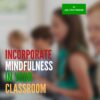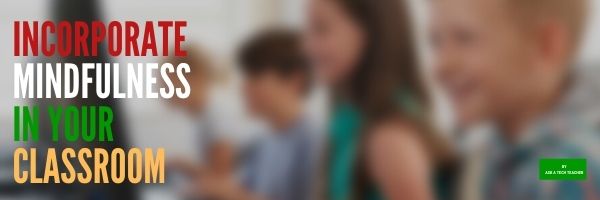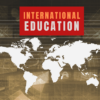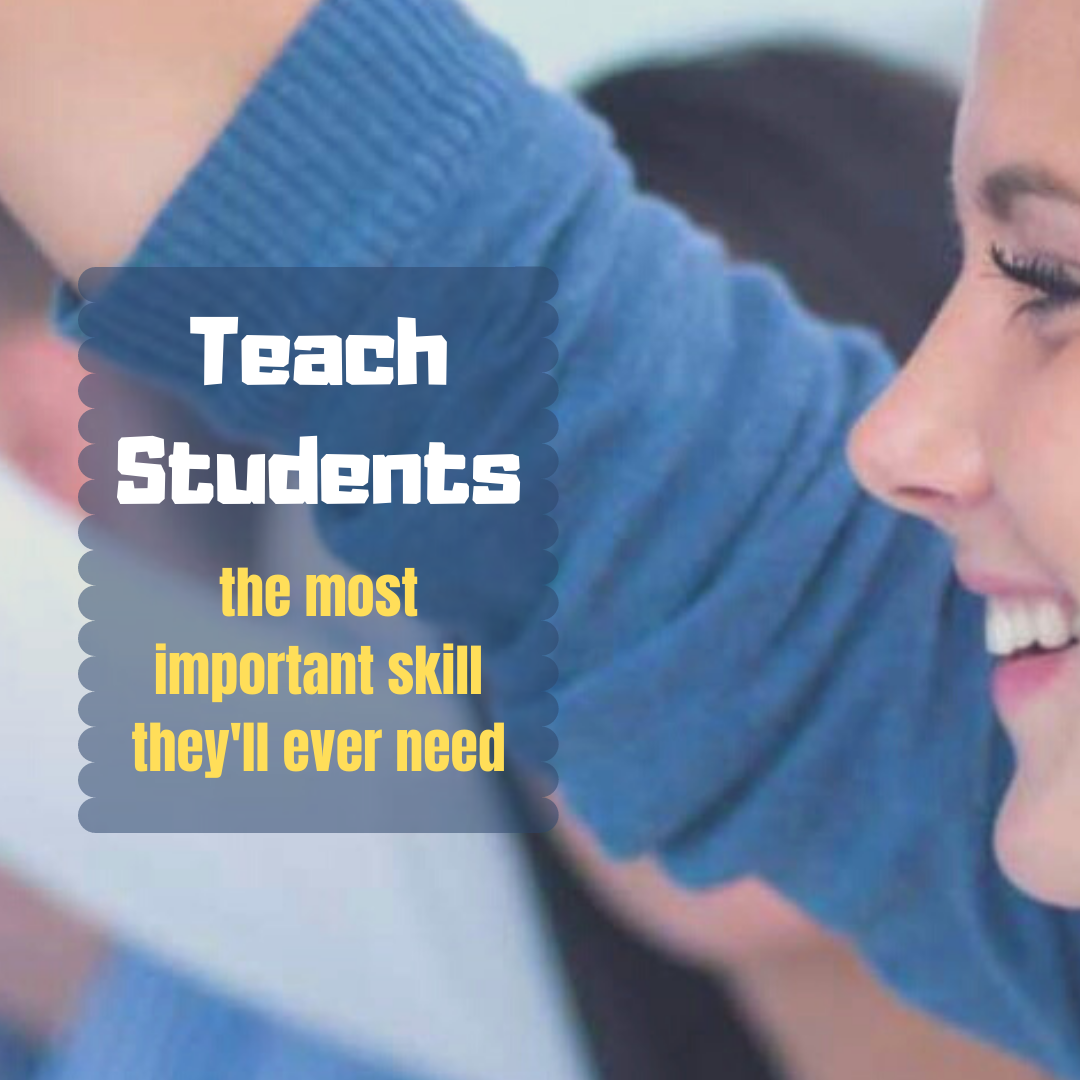Category: Education reform
Does Mindfulness Make Your Class Better?
District Administration recently published an interesting article on how mindfulness creates kinder classrooms and reduces problematic behaviors by 18%. Click the link and check out their thoughts.
If you’d like background on Mindfulness, check our article published earlier on
How to Incorporate Mindfulness into Your Class
Students learn best when they are relaxed, happy, and feeling loved. It is challenging to include those characteristics in classes when you are concurrently trying to achieve school goals, comply with curriculum timelines, juggle parent concerns, and blend your lessons with those of colleagues.
This is where mindfulness becomes important. It reminds teachers that the fulcrum for learning is the student’s emotional well-being.
Let’s back up a moment: What is mindfulness? Buddha said:
“Do not dwell in the past, do not dream of the future, concentrate the mind on the present moment.”
If that’s the plan, mindfulness is the path. It teaches students how to quiet themselves — get to a place where their mind is settled sufficiently to pay full attention to the task at hand. Experts offer many suggestions for incorporating mindfulness into your classroom experience. Consider:
- pause and take a deep breath before beginning an activity or in the middle of performing it
- reflect on an activity as a group
- reflect on the student’s own experiences and background and how that relates to the topic
Delving into these rudimentary steps isn’t the goal of this article. Today, I’ll share five ideas on taking mindfulness to the next level in your classes:
Share this:
- Click to share on Facebook (Opens in new window) Facebook
- Click to share on X (Opens in new window) X
- Click to share on LinkedIn (Opens in new window) LinkedIn
- Click to share on Pinterest (Opens in new window) Pinterest
- Click to share on Telegram (Opens in new window) Telegram
- Click to email a link to a friend (Opens in new window) Email
- More
Creative Options for Remote Learning
With schools closed for in-person learning and many children being educated at home, parents are scrambling for quality alternatives that work in a home environment. One of our Ask a Tech Teacher contributors has some ideas you may not have thought of:
How to Make Remote Learning Work For Your Children
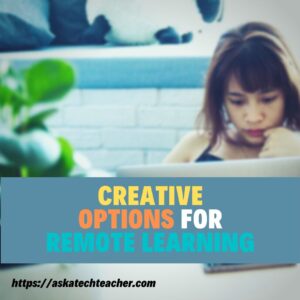 Many parents are choosing to opt-out of traditional schooling, but the question of how to create a well-rounded curriculum or who to hire for this task is often the barrier that prevents at-home learning. In this article, we’ll help you make a decision by presenting popular remote learning options or childcare resources that can support homeschooling or non-traditional approaches.
Many parents are choosing to opt-out of traditional schooling, but the question of how to create a well-rounded curriculum or who to hire for this task is often the barrier that prevents at-home learning. In this article, we’ll help you make a decision by presenting popular remote learning options or childcare resources that can support homeschooling or non-traditional approaches.
Traditional Homeschooling
Homeschooling is a progressive movement where parents educate their children instead of sending them to public or private schools. Families will choose this option for various reasons, including dissatisfaction with public education, constant relocation, or a bad social environment.
Some of the many positives of homeschooling your children include:
- Home-educated children score 15 to 30 percentile points higher than other students.
- Homeschooled children get accepted by colleges at a higher rate than other students.
- Homeschool helps children develop better social skills than their public school peers.
- Special needs children receive a significantly higher level of education on average.
- Adults who were homeschooled are more politically tolerant and happier on average.
Homeschooling is legal in all 50 states, but the legal requirements for this education option vary from place to place. If you’re in the process of pulling your children out of public education, you’ll need to write a letter of withdrawal to the school board that describes your intent to homeschool.
There are many curriculum options available for parents. As long as your curriculum of choice follows the requirements of your state, they can apply for college once they graduate. Parents don’t need a formal teaching degree to qualify as homeschool teachers. It may be beneficial for you to take an online course that goes over teaching fundamentals and how to run a classroom.
Share this:
- Click to share on Facebook (Opens in new window) Facebook
- Click to share on X (Opens in new window) X
- Click to share on LinkedIn (Opens in new window) LinkedIn
- Click to share on Pinterest (Opens in new window) Pinterest
- Click to share on Telegram (Opens in new window) Telegram
- Click to email a link to a friend (Opens in new window) Email
- More
Technology is Here to Stay: Now What?
Ask a Tech Teacher contributor, Christian Miraglia, taught for 36 years before retiring. He has some interesting reflections on technology’s place in education:
***
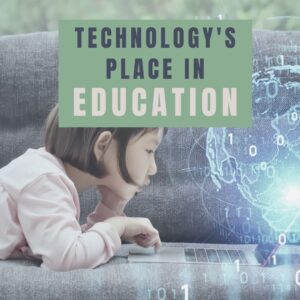 Remember the days of Oregon Trail on the old Apple IIe’s or students drawing pictures with Kid Pix. Much has changed since technology has made inroads into education, and much has not. I recently retired from public school teaching after thirty-six years as both a US History teacher and TOSA. I dedicated much of my career to finding the appropriate role of technology in the classroom. Although the pedagogy of utilizing technology was not readily available in the early 1990s for educators, it is ever-present today. Companies with a vested interest in their products publish studies touting their applications. I tend to favor independent studies on technology use which take a more balanced approach. However, one thing seems to be lacking: the input of users who will integrate these products in their daily lessons.
Remember the days of Oregon Trail on the old Apple IIe’s or students drawing pictures with Kid Pix. Much has changed since technology has made inroads into education, and much has not. I recently retired from public school teaching after thirty-six years as both a US History teacher and TOSA. I dedicated much of my career to finding the appropriate role of technology in the classroom. Although the pedagogy of utilizing technology was not readily available in the early 1990s for educators, it is ever-present today. Companies with a vested interest in their products publish studies touting their applications. I tend to favor independent studies on technology use which take a more balanced approach. However, one thing seems to be lacking: the input of users who will integrate these products in their daily lessons.
Those first years of the excitement of having a computer for one class in which students would perform of what we would consider a primitive use of gaming seemed so distant. Many platforms offer a more advanced gaming process that builds student vocabulary or is more engaging today. Edudadoo, Endless Alphabet, Spelling City are just a few. Applications on readily available for Chromebooks, IOS, and Microsoft platforms. Integrations into delivery platforms abound. The ongoing debate on whether to use Pear Deck or NearPod is one that I am familiar with. The question arises, “How does one know if the applications have an impact on student learning?”
My approach was to pilot any software application, if possible, for at least 90 days. Most companies offer such opportunities. Although not a data scientist, I documented how the students interacted with the platform. Typically students enjoyed the novelty of something new and exciting, especially if the tools allowed them to become more than passive participants. However, I made sure that students understood that this was a new integration, and it was vital for them to provide feedback on the platform. I remember one particular platform a couple of years ago that had a draw option. Being integrated into my delivery platform, and the students asked if I could incorporate it daily. I had to consider whether the function was more of a distraction because they could spend time drawing or representing learning ideas in my history classroom. After at least 30 days of usage, I concluded that the platform had some perks that enhanced student learning. Not only was I involved in the process, but I utilized student input via a brief survey. Student agency can occur at any level of instruction, including technology integration.
Share this:
- Click to share on Facebook (Opens in new window) Facebook
- Click to share on X (Opens in new window) X
- Click to share on LinkedIn (Opens in new window) LinkedIn
- Click to share on Pinterest (Opens in new window) Pinterest
- Click to share on Telegram (Opens in new window) Telegram
- Click to email a link to a friend (Opens in new window) Email
- More
Education in Kosovo
I had an opportunity to chat with Doruntina Alshiqi about the education system in Kosova. I love hearing how learning is accomplished around the world. It reminds me that we live in a bubble, thinking our approach is great but often, other systems work just as well. I found it fascinating to hear Doruntina’s experience. I think you will too.
***
 Primary education is provided for students here. It consists of schooling from grade one through five. This is a requirement by law for all children and students enroll at the age of six. The second component of education is the lower secondary educational system, which is usually for teens around 12 to 15 years of age. It provides education through grade nine. This is publicly funded and free of charge.
Primary education is provided for students here. It consists of schooling from grade one through five. This is a requirement by law for all children and students enroll at the age of six. The second component of education is the lower secondary educational system, which is usually for teens around 12 to 15 years of age. It provides education through grade nine. This is publicly funded and free of charge.
From here, students move on to secondary education. This is either professional education or general education. Most students spend three to four years at this level. This level of education is not a requirement under law, though. Most students who enroll in it do so to learn trades and skills that they will use to build their careers and lives with. These schools have a goal to prepare students for vocational work directly out of school or to prepare them to enter university.
Higher Education in Kosovo
Much of the country is rebuilding and reorganizing. This includes the educational system in the country. Universities and educational institutions provide higher education in Kosovo. Both private and public schools are available here at this level. Students are able to earn an associate’s degree, which generally takes under two years to complete in a specialized area of study, a bachelor’s degree, which takes between three and four years to complete, or a masters degree, which can add an additional two to three years of education on. Post graduate education to earn a PhD is also available. Many students enroll in these programs part time, though full time education is still widely available as well.
It is important to note that many of the schools, under the guidance of the Ministry of Education, Science, and Technology is being altered. The goal is to align the educational system along the lines of other European countries.
Share this:
- Click to share on Facebook (Opens in new window) Facebook
- Click to share on X (Opens in new window) X
- Click to share on LinkedIn (Opens in new window) LinkedIn
- Click to share on Pinterest (Opens in new window) Pinterest
- Click to share on Telegram (Opens in new window) Telegram
- Click to email a link to a friend (Opens in new window) Email
- More
Edtech Trends From 2020 And Beyond
Hi there, my name is Roman Zhidkov, a happy contributor to Ask a Tech Teacher. I’m the CTO of a tech company and for more than five years I have been busy with teaching programming courses and sharing my expertise with novice specialists. I can tell from experience that it’s a prerequisite for a teacher to follow trends due to the fast-changing market and nuances of working with young professionals with a progressive mindset.
Besides, the living conditions can dramatically change at any moment like it has been with the COVID-19 pandemic. That’s why it’s better to prepare for any changes in advance. So, in this article, I’m going to share my thoughts and experience about the technologies and solutions that reshape the educational industry and the way we learn in 2020 and beyond.
6 Edtech Trends to Keep an Eye On
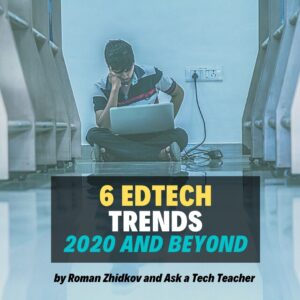 The educational field was constantly evolving along with new technologies even before the pandemic. However, due to the rapid spread of the coronavirus and the global lockdown, distance learning became vital in 2020. That led to a rise of different e-learning platforms and solutions such as learning management systems (LMSs), learning experience platforms (LXPs), learning analytics platforms (LAPs), and so on. All that opened a lot of doors and possibilities for both teachers and students.
The educational field was constantly evolving along with new technologies even before the pandemic. However, due to the rapid spread of the coronavirus and the global lockdown, distance learning became vital in 2020. That led to a rise of different e-learning platforms and solutions such as learning management systems (LMSs), learning experience platforms (LXPs), learning analytics platforms (LAPs), and so on. All that opened a lot of doors and possibilities for both teachers and students.
Integration of various technologies can help you to improve the courses, making the process more engageable, immersive, personalized, effective, interacting, etc. Below you’ll find 6 tech trends that are must-have in 2020 and beyond. Let’s analyze them to find out what profit they offer.
Video-Based Learning
Do you know that 70% of millennials used YouTube videos for learning something new even before the quarantine? And due to the pandemic, video-based learning is booming in distance learning conditions because all we — teachers — were forced to use the technology during the lockdown.
And I can say that watching my students, who come to my courses to gain knowledge, the effectiveness of learning not only didn’t begin a downturn but raised. Videos are extremely beneficial to make content comprehensible and enrich lessons. All that not only improves the learners’ outcomes but reduces teachers’ workload.
The key features of video-assisted learning are scalability and repetitiveness. Thus, you can record a series of lectures and students can watch them at any time, anywhere. Besides, lecturers can prepare such types of videos as:
Share this:
- Click to share on Facebook (Opens in new window) Facebook
- Click to share on X (Opens in new window) X
- Click to share on LinkedIn (Opens in new window) LinkedIn
- Click to share on Pinterest (Opens in new window) Pinterest
- Click to share on Telegram (Opens in new window) Telegram
- Click to email a link to a friend (Opens in new window) Email
- More
5 reasons why outdoor learning is vital for young children
 Great reminder about the importance of play from one of our Ask a Tech Teacher contributors
Great reminder about the importance of play from one of our Ask a Tech Teacher contributors
Outdoor education might sound like a modern fad to many. However, there are so many advantages to this that it is critical for young children. Continue reading to find out why.
- Dispel the myth that learning only occurs in school
Many people, not just children, believe that learning only happens within the school building. It is something formal, something strict, and something planned. This couldn’t be further from the truth. Plus, teachers aren’t the only educators in a child’s life; parents, siblings, grandparents, club leaders and so on all play a part.
- Apply learning in different contexts
If children only learn about the value of money within a classroom, they may not be able to apply that skill to their own lives. For example, a child who has the opportunity to go to the shop and spend a dollar will understand the concept of exchanging money for an item far better than someone who only completes a worksheet based on it. The same goes for skills like measuring. Why should children only be made to measure the length of things within a classroom? In the great outdoors, people building enclosures for their animals, a new fence for their garden or setting up a campsite will all need to use the skill of measuring. Furthermore, understanding the use of technology within life outside of school is vital too. Many teachers encourage the use of an electronic device to help measure or a website to support learning.
- Promotes active lifestyle
“Stop running!” School buildings are a place where you must not run or jog, unless of course, you are a teacher in a rush. Rules can be broken then. When classrooms are done badly, they create passive individuals. Learners who follow the rules, but who are not fully engaged in what they are doing. Take the pupils outdoor,s and what do they do first? They run around! There are fewer limitations imposed on them and it allows them to not only be active in terms of their engagement, but also their physical selves. Who says that a child can’t successfully learn their times tables while taking part in games outdoors?
- Learn through play
Learning through play is the most common method of education for young children. Play comes naturally in the great outdoors as there are fewer limitations and more opportunities. This preschool Utah outdoor space just shows what is possible. Although a classroom setup may have a role play area, for example, it also has more formal areas in which children know they will have to sit and learn. Spending time outdoors and allowing the children to create their own opportunities for learning is essential. Anna Ephgrave’s Planning in the Moment approach is perfect for this.
- Physical and sensory approach works for younger children
Many children rely on a physical and sensory approach to learning when they are young. The outdoors is the obvious choice for many to have this opportunity. It seems much more acceptable to encourage water and messy play outside.
Although we feel strongly that children should be actively encouraged to spend time outdoors during their early years of education, the advantages can certainly continue into later life too. It is also vital to ensure the environment itself is fit for purpose, providing prompts and apparatus to support their learning.
More on play and learning
How to Blend Learning with Play for a Kid-friendly Summer
Learning and Playing and Why Both Matter for Teachers
Jacqui Murray has been teaching K-18 technology for 30 years. She is the editor/author of over a hundred tech ed resources including a K-12 technology curriculum, K-8 keyboard curriculum, K-8 Digital Citizenship curriculum. She is an adjunct professor in tech ed, Master Teacher, webmaster for four blogs, an Amazon Vine Voice, CSTA presentation reviewer, freelance journalist on tech ed topics, contributor to NEA Today, and author of the tech thrillers, To Hunt a Sub and Twenty-four Days. You can find her resources at Structured Learning.
Share this:
- Click to share on Facebook (Opens in new window) Facebook
- Click to share on X (Opens in new window) X
- Click to share on LinkedIn (Opens in new window) LinkedIn
- Click to share on Pinterest (Opens in new window) Pinterest
- Click to share on Telegram (Opens in new window) Telegram
- Click to email a link to a friend (Opens in new window) Email
- More
Curriculum-based Assessments–A Powerful Diagnostic Tool
 Curriculum-Based Assessment (CBA), often equated with Curriculum-Based Measurement (CBM), is any form of assessment that measures progress toward fulfillment of a stated curriculum. More succinctly:
Curriculum-Based Assessment (CBA), often equated with Curriculum-Based Measurement (CBM), is any form of assessment that measures progress toward fulfillment of a stated curriculum. More succinctly:
“…repeated, direct assessment of targeted skills in basic areas using materials taken directly from the teaching curriculum”
While CBA is assessment based on the curriculum, it isn’t chapter tests from a text. The latter measures student achievement of a particular set of lesson knowledge while the former measures student achievement of the broader class goals. CBAs are useful not only to measure student learning within a unit but over time toward larger goals.
How does it work
There is no setup required to start using CBA — no website signup or software download. What you will have to do — and may already do — is identify the criterion you are committed to accomplishing with students. These will be beyond what is required of the State or National standards and may or may not align perfectly with the textbooks you use. They are developed by you, likely in conjunction with grade-level teammates and your school administration. They help you identify your goals and the resources required to achieve them and then measure progress toward their completion.
Once these are in place, you devise the assessments — formative and summative — that will provide the evidence of achievement. This is done exactly as you would normally develop assessments during a unit of inquiry to evaluate progress and — at the end of the unit — to evaluate success with one big difference: Curriculum based assessments evaluate progress toward broad learning goals rather than textbook chapters or lesson plans.
You continue to teach classes as you normally would, with lesson plans, projects, and resources aimed to teach critical standards laid out by the school, the State, or the nation. These may be augmented with a scope of criterion — sometimes replaced with a Scope and Sequence or Curriculum Map — to be used as references in measuring learning. Here you will carefully identify the criterion CBA will use to provide and measure evidence of learning. These can be 1) measured against what is expected (called “benchmarks”), or 2) measured against prior assessments.
Share this:
- Click to share on Facebook (Opens in new window) Facebook
- Click to share on X (Opens in new window) X
- Click to share on LinkedIn (Opens in new window) LinkedIn
- Click to share on Pinterest (Opens in new window) Pinterest
- Click to share on Telegram (Opens in new window) Telegram
- Click to email a link to a friend (Opens in new window) Email
- More
5 Ideas for Teaching Students the Most Important Skill They’ll Need
Every teacher I know understands it’s not the 3R’s or science or even history that provides fundamental skills for thriving in life. If you doubt that, read the quote below from a Harvard professor about the half-life of learned skills. No, it’s something more basic, more intuitive, and happens to be the holy grail of teacher goals for students.
Learn how to learn
Here’s how to make this easy, from an Ask a Tech Teacher contributor:
***
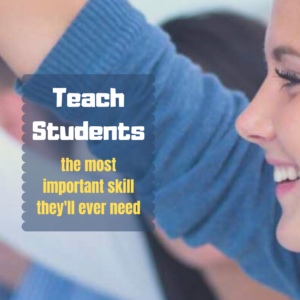 In the past, a university degree provided a majority of graduates with the skills they needed to succeed in their chosen careers. In the 2020s, this is no longer the case. Today, according to research conducted by Harvard Business Review and Deloitte, a college degree typically provides students with skills that have a half-life of only 5 years.
In the past, a university degree provided a majority of graduates with the skills they needed to succeed in their chosen careers. In the 2020s, this is no longer the case. Today, according to research conducted by Harvard Business Review and Deloitte, a college degree typically provides students with skills that have a half-life of only 5 years.
That means it won’t be long before even college-educated employees will need to upskill or retrain to remain employable.
The main takeaway: Learning how to learn is the single most important skill that our students will need to master if they hope to participate meaningfully in the fast-paced, technology-driven workplace of the future.
Yet many students do not have a solid understanding of how to effectively go about the process of upskilling. According to research published in the Instructional Science journal, individual students experience a broad variety of differentiation in their understanding of how to undertake the learning process. Sadly, it is possible for some students to make it all the way through twelfth grade without ever fully grasping the basics of how to learn.
In hindsight, it’s easy to see how this could happen. As educators, we are each tasked with teaching our students a specific body of knowledge. The knowledge typically encompasses highly focused topics such as reading or math or biology. We know our students will be tested on the knowledge that we’ve been trusted to impart to them. Our livelihoods directly depend on whether or not they will excel at the resulting tests. There isn’t room in our workdays to deviate far from the material that will be covered on the tests.
Rarely, it seems, is anybody ever specifically tasked with teaching students a step-by-step course in how to learn. Yet, collectively, if we fail to teach them this skill, we ultimately fail in our mission to equip our students with the skills they’ll need to succeed in their careers — and also to succeed as functioning members of a technologically advanced society.
How, then, can we take action to teach our students how to learn? The following are five ideas we might each have the opportunity to implement as we approach the task of teaching our everyday curriculum to our students:
Share this:
- Click to share on Facebook (Opens in new window) Facebook
- Click to share on X (Opens in new window) X
- Click to share on LinkedIn (Opens in new window) LinkedIn
- Click to share on Pinterest (Opens in new window) Pinterest
- Click to share on Telegram (Opens in new window) Telegram
- Click to email a link to a friend (Opens in new window) Email
- More
13 Teaching Strategies to Shake up Your Remote Teaching
 As we struggle with adapting our classes to remote learning, I know lots of teachers who are realizing that their normal approach isn’t suited for remote teaching. They need to come up with a transformative tool that will reach students more comprehensively, more rigorously, more granularly online. Here are thirteen accepted pedagogical teaching strategies with proven records of success. Read through them then think how they might be applied to solve the problems you’re having with online teaching. For more information, click the link:
As we struggle with adapting our classes to remote learning, I know lots of teachers who are realizing that their normal approach isn’t suited for remote teaching. They need to come up with a transformative tool that will reach students more comprehensively, more rigorously, more granularly online. Here are thirteen accepted pedagogical teaching strategies with proven records of success. Read through them then think how they might be applied to solve the problems you’re having with online teaching. For more information, click the link:
Depth of Knowledge (DoK)
DoK is not a taxonomy (like Bloom’s). Rather, it itemizes ways students interact with knowledge.
Frayer Model
Frayer Model uses a graphical organizer that asks students to describe words by much more than a memorized definition.
Growth Mindset
In a Growth Mindset, people believe ability can be developed through dedication and hard work. The cerebral and physical traits they were born with are just the starting point. Students are responsible for setting the patterns and strategies that allow them to succeed, by evaluating what they can do at any given point and making a plan for learning everything else.
Habits of Mind
In the face of mounting evidence, education experts accepted a prescriptive fact: student success is not measured by milestones like ‘took a foreign language in fifth grade’ or ‘passed Algebra in high school’ but by how s/he thinks. Habits of Mind lists sixteen of these.
Orton-Gillingham
Orton-Gillingham is not a packaged curriculum, rather a prescriptive program designed for each individual student. The O-G teacher incorporates phonology and phonological awareness, sound-symbol association, syllable instruction, morphology, syntax and semantics into a personalized methodology
Project-based Learning (PBL)
John Dewey suggested the education focus be switched to students when he introduced “learning by doing”, today referred to as Project-based Learning (PBL).
Share this:
- Click to share on Facebook (Opens in new window) Facebook
- Click to share on X (Opens in new window) X
- Click to share on LinkedIn (Opens in new window) LinkedIn
- Click to share on Pinterest (Opens in new window) Pinterest
- Click to share on Telegram (Opens in new window) Telegram
- Click to email a link to a friend (Opens in new window) Email
- More
How to Assess Digital Literacy
 On my blog, Ask a Tech Teacher, I run a column called Dear Otto where I answer teacher questions about how to integrate technology into their classes. Of late, the most common question is, “How to I assess student digital literacy?” with a close cousin, “I am the tech integration specialist. How do I assess faculty digital literacy so I can teach them what they don’t know?”
On my blog, Ask a Tech Teacher, I run a column called Dear Otto where I answer teacher questions about how to integrate technology into their classes. Of late, the most common question is, “How to I assess student digital literacy?” with a close cousin, “I am the tech integration specialist. How do I assess faculty digital literacy so I can teach them what they don’t know?”
Happily, both can be accomplished the same way. But before I tell you how, let’s step back and talk about the meaning of “digital literacy”.
What is digital literacy?
The definition of digital literacy is pretty much what you’d expect:
“the ability to use information and communication technologies to find, evaluate, create, and communicate information, requiring both cognitive and technical skills.” –from the American Library Association
In the past, I discussed the eight skills required for students to be considered digitally literate. Today, I want to focus on the need to assess digital literacy and what tools are available to do this.
Why assess it?
Especially today–in a COVID-19 world–this is a good question. Here are the five most common reasons schools feel the need to assess student and faculty digital literacy:
Share this:
- Click to share on Facebook (Opens in new window) Facebook
- Click to share on X (Opens in new window) X
- Click to share on LinkedIn (Opens in new window) LinkedIn
- Click to share on Pinterest (Opens in new window) Pinterest
- Click to share on Telegram (Opens in new window) Telegram
- Click to email a link to a friend (Opens in new window) Email
- More

